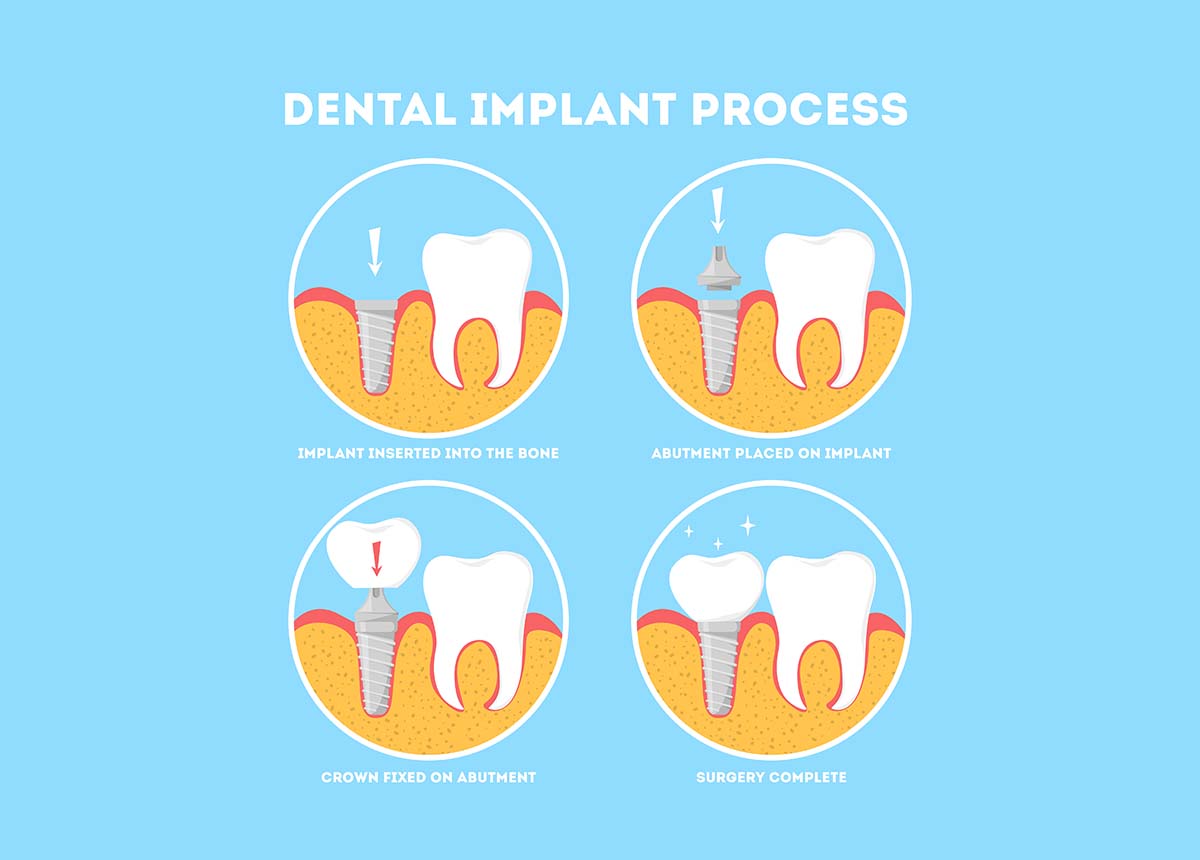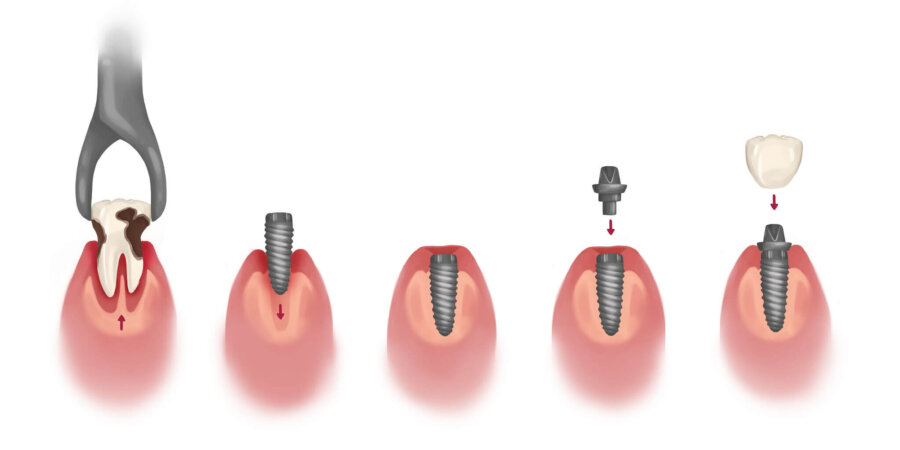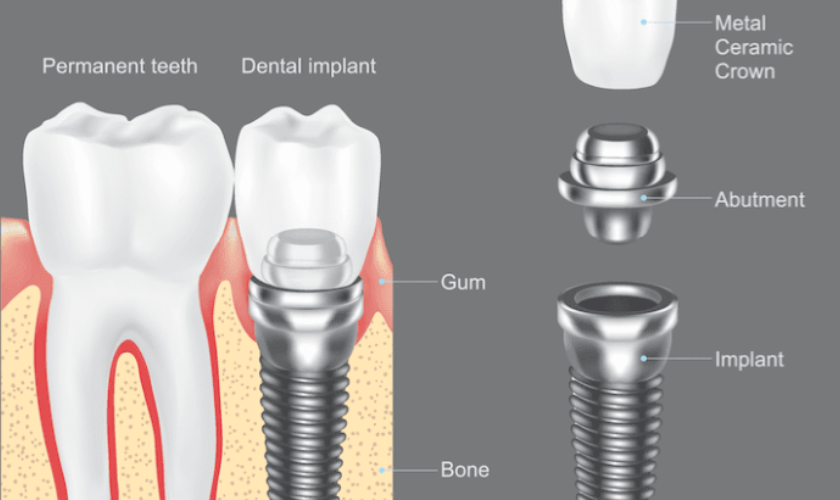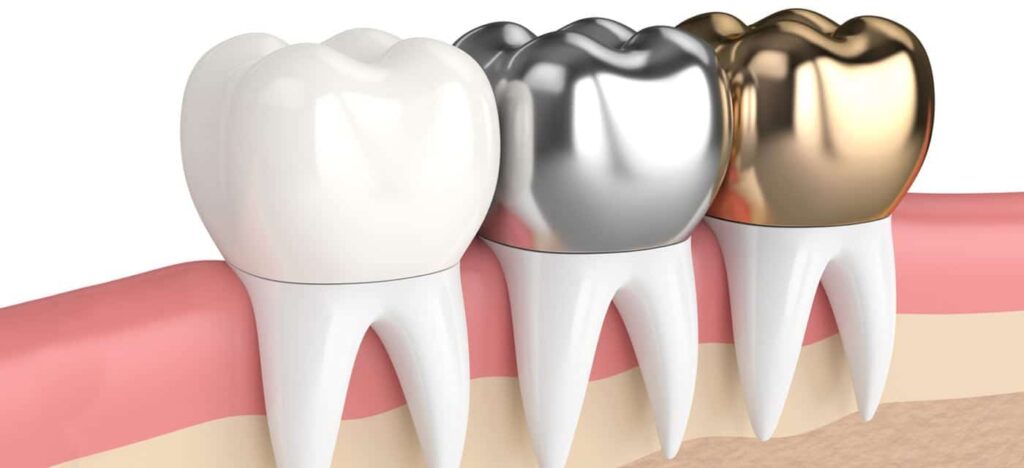Dental implants are not easy. Therefore, clients need to know every step of the implant surgery process. This blog brings transparency by laying out the step-by-step process of dental implants below.
Overview

Dental Implants bring various benefits to the patients, including ease of speaking, chewing, and an enhanced aesthetic appearance. They consist of metal roots implanted surgically into the jawbone. The top of the implant is covered with bridges or crowns so the implant can work and look like natural teeth.
The procedure of dental implants may vary from person to person. The factors contributing to variations may be health conditions, allergic reactions, infection, condition of jawbone, etc. Depending on these factors, patients have to go through several procedures and breaks in between for proper recovery and successful implant surgery.
Step-by-Step Process of Dental Implants

Dental Implants are not a single-appointment treatment. It takes various trips to your dentist to complete each implant step properly. The whole process of dental implants takes several months to let the bone heal and the implant fix properly.
Initial Evaluation
The process of dental implants begins with an initial examination of the teeth and other health conditions. The dentists examines the jawbone health, tooth condition, and other related queries to create a proper plan for you.
The dentist takes x-rays and impressions of your natural teeth to evaluate the situation and carry out further tasks. Further, in the initial evaluation, you should discuss your medical conditions, current medications, oral health condition, anaesthesia options, and how many teeth you want to replace etc. All of these queries need a proper discussion with the specialist so the next process can begin smoothly.
Tooth Extraction
This step is optional if you still have a remaining, damaged, rotten, or dead tooth/teeth. The implants begin by removing the existing teeth. This process involves local anaesthesia to numb any pain or sensitivity during the process.
Tooth extraction before dental implant surgery does not take a long time. It is a quick step in the dental implant process. It can happen before the surgery or at the time of the implant. If you get your tooth extraction before the implant insertion, you should avoid blowing your nose, smoking, spitting, excessive coughing, hard chewing, and drinking through a straw. It may cause pain and complications in the future.
Bone Grafting
The initial examination involves examining the jawbone condition because the implant needs to be inserted into the bone. Therefore, the jawbone must be strong enough to hold the implant. If the jawbone is strong, the process of dental implants fast forwards to implant insertion.
However, if the jawbone is weak, the successful surgery requires bone grafting to make it strong enough to endure the pressure of chewing. Bone grafting is bone transplantation to strengthen it. The dentist takes some extra bone from another area of the jawbone. He transplants it into the target area.
Once the bone is added, it takes some time to let the jawbone heal. After the jawbone heals, the dentists move to the next process.
Implant Insertion
If you have received bone grafting surgery, you need to wait for implant insertion to let the bone heal completely. It may take a few months. The next step in the process of dental implants is implant insertion.
It is a surgical process that involves cutting down the gum and drilling the jawbone to make space for the implant. After drilling the bone, the dentist screws the implant into the bone.
Abutment Placement

Abutement is a metal piece placed between the implant and the crown. It connects the two parts. Sometimes, the dentist fixes the abutment at the time of the implant insertion or several days after. The abutment must be tight enough to strongly hold the crown to the implant. It is not a painful or time-consuming process. After placing the abutment, The specialist covers it with a healing cap to protect the abutment from tissues or bone growing over the implant.
Crown Placement
After the period of gum healing, the final step in the process of dental implants is the placement of an artificial crown. You can either choose a removable crown or a fixed crown. It is your preference to choose between the two. A fixed implant is impossible to remove or replace as it is permanently screwed into the implant.
Conclusion
Dental implant surgery is a long process. There are several steps involved in this surgery as after every step, the gums and jawbone require time to heal. So, before, getting an implant, keep in mind that you will have to visit again and again for various steps. After the surgery, one needs to take care of a diet plan, care instructions for longevity, and other precautions.
Now you are aware of all the steps involved. You can visit the Teeth and Smile Dental Clinic at Gulberg 3, Lahore. Here we have a team of specialist dentists. You can book an appointment online and get ready for a consultation.
FAQs
What are the stages of a dental implant?
Dental implant surgery requires various stages like initial examination, tooth extraction, bone grafting, implant insertion, abutment placement, and lastly crown placement.
What is the process of dental implants?
Dental implants are a lengthy process. You cannot get this service in one appointment, and a successful implant may take several months.
How long is the process of getting dental implants?
Successful tooth implant surgery may vary from person to person depending on healing speed and jawbone condition. However, the entire process may last 5 to 8 months.
How long do you go without teeth when getting implants?
The duration of staying without teeth may vary from person to person. However, once the implant is placed, the dentist provides a healing cap. But, you may have to stay toothless for some months to complete all the stages of the implant.
How many sittings for a dental implant?
Usually, dental implants require a minimum of three sittings: initial examination, implant placement, and crown placement. However, sittings may be increased depending on your jawbone condition, tooth condition, etc.



